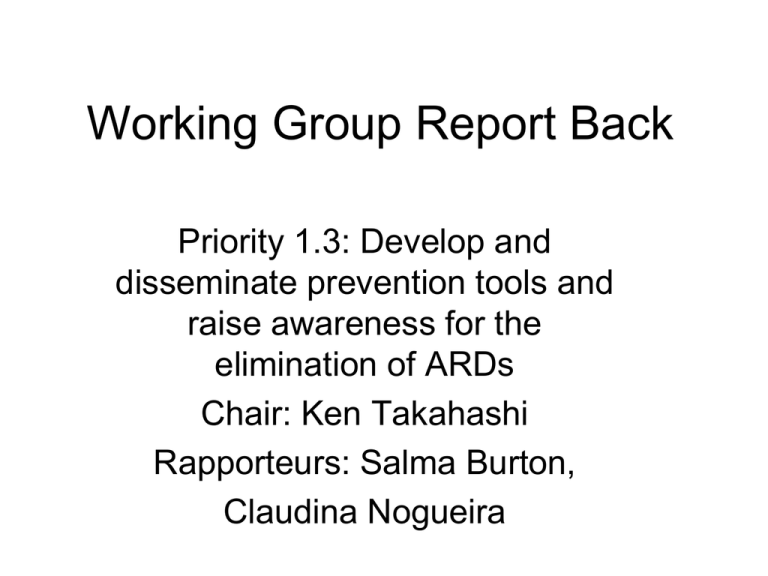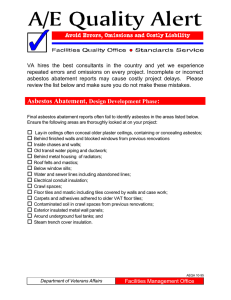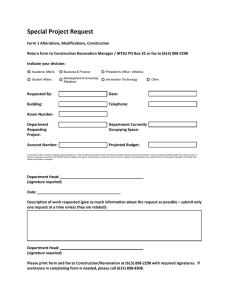Working Group Report Back
advertisement

Working Group Report Back Priority 1.3: Develop and disseminate prevention tools and raise awareness for the elimination of ARDs Chair: Ken Takahashi Rapporteurs: Salma Burton, Claudina Nogueira Measurable Key Outcomes 2012 • Training video for health and hygiene experts on prevention of asbestos-related diseases [in English] (completed) JAPAN – to be posted for e-access • Compilation of National Profiles (NPEAD) in multiple countries – collaborate with PAHO on Regional Atlas Measurable Key Outcomes 2012 • Increase in number of countries supported by WHOCCs to ratify ILO Convention N.162. (currently 28) - through their awareness-raising activities, particularly on the regulatory control of chrysotile asbestos. Countries which have ratified the convention are urged to share information on process and progress, for the benefit of other countries. Measurable Key Outcomes 2012 • Review of estimates of current and future burden of disease for all ARDs to be used as support documentation for ratification (which can be peer-reviewed by WHOCCs) and assist with policy development . Countries to develop their own national estimates, and include cost analysis. Gaps to be addressed • Lack of updated information and data about asbestos exposure (direct and indirect) – e.g. magnitude and number / types of workers affected - and about ARDs. • There are insufficient job exposure matrices these should be developed in collaboration with environmental and public health institutions. (Utilize NPEAD which address important information related to asbestos use). Gaps to be addressed • Limited data on the effectiveness of preventive measures – to provide models of effective interventions – look to PAHO Regional Atlas for guidelines – consider cost effectiveness analysis as an important component of substitution / elimination / control measures / disposal – Organization of practical tools in one place for use by others, e.g. data repository. Consider using existing resources Gaps to be addressed • Currently there is no project for Area 3: Tertiary Prevention: – develop, promote, share schemes for just compensation of ARDs – manage treatment of asbestosis Barriers and solutions • Consider addition of new projects (with no links to commercial interests) from WHOCCs to help address gaps: - NEW from FUNDACENTRO, Brazil: Lung function decline among former asbestos workers; and mortality study. - NEW from Ukraine: Work environment measurements and ARDs in asbestos cement production. - NEW from Korea: Surveillance of asbestosrelated lung cancer. Barriers and solutions • NEW from ICOH: Scientific Committee on Respiratory Disorders – position paper on prevention strategies to be distributed after ICOH clearance. • NEW Asbestos awareness-raising in the Asian Pacific Region • PAHO Link: Asbestos Regional Atlas • Cross-referencing with projects outside Priority 1.3 will contribute to addressing gaps Barriers and solutions • Lack of political will • Industry counter-lobby Long term deliverables (20132016) • Contribute to increasing the number of countries establishing and implementing NPEAD – at least 15-20 countries. • Sufficient capacity (legislation, regulatory control, preventive measures, worker awareness) built for the three levels of prevention in all countries with substantial asbestos exposure, with a special focus on developing countries. Communication and Reportable Outcomes • Awareness-raising through international meetings, workshops, publications and data sharing. • Use of specific portals. • Working with ministries and convening regional meetings to showcase asbestos work being carried out by the WHOCCs. Communication and Reportable Outcomes • Regional meetings facilitated by WHO HQ and Regional Offices, highlighting WHO CC work and involving other stakeholders (e.g. UN agencies and NGOs), as currently planned for Asian Pacific area (December 2009, Thailand) Communication - General • Assistance is required for the electronic redesignation process as many glitches have been experienced with the submission of applications on-line. Communication and Reportable Outcomes • Regional Offices to assist project leaders and WHOCC for direct liaison with government ministries and WHO Country Offices to obtain data and records which are crucial for the implementation of their projects. • The Responsible Officer for the particular region is a key player in assisting and supporting the WHOCC in carrying out their projects.




